Sony Alpha DSLR-A330
-
-
Written by Gordon Laing
Sony Alpha DSLR-A330 design, controls, screen and live view
Sony has completely redesigned the Alpha A330’s body, to give it a unique look and feel compared to rival models. The grip in particular is quite unusual, being shorter than most and lacking the usual overhang at the top which prevents your middle finger from slipping. Viewed from above it’s equally unique, with the grip coming to a relatively narrow tip that’s not particularly deep either. We’ve pictured the Alpha A330 below, alongside Canon’s EOS 1000D / Rebel XS, which is much more traditional in its ergonomics.
 | |
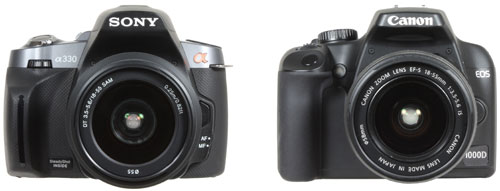 |
We always recommend picking up a camera in person to see how well it fits your own hands, but this is more important than ever with the Alpha A330, as its grip really is unlike anything else on the DSLR market right now (apart from of course its siblings, the A230 and A380). As always, it’s highly subjective, but we just didn’t get on with the A330’s grip, as there’s little to grab hold of and nothing other than the rubber coating to stop your fingers from slipping. Thank goodness then for the conventional thumb rest on the rear which allows a reasonable secure hold, but overall we’re not fond of the new design. We’d be interested to hear what you think in the Cameralabs forum.
The smaller grip is partly to stand out from the crowd, but also to save on size and weight, two areas which Sony’s focus groups have described as deal-breakers for those upgrading from a point-and-shoot to a DSLR. Sony’s put effort into reducing both the size and weight of the A330 over its predecessor, and certainly succeeded in this goal: measuring 128x97x71mm, it’s 3mm less wide, 2mm shorter and 4mm thinner than the earlier A300, and at 539g, a comfortable 121g lighter too when both bodies are fitted with their respective batteries.
But some of that weight loss is thanks to a new, weaker battery with much reduced lifespan (see bottom of page), and while the A330 is indeed smaller and lighter than the A300, it remains on the chunky side compared to many rivals. Canon’s EOS 1000D / Rebel XS is roughly the same width and height, but 9mm thinner and 39g lighter, while the Olympus E-620 may be 3mm wider, but is 3mm shorter, 11mm thinner and 18g lighter.
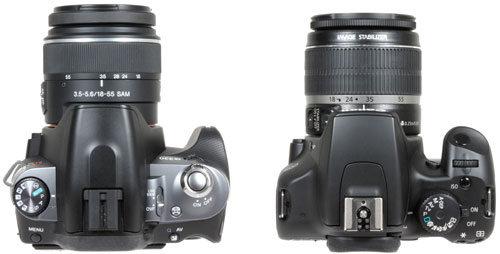 |
Sony can’t use the excuse of having built-in stabilisation and an articulated screen either, as the Olympus E-620 also features both. To be fair, another rival, the Nikon D5000 is actually 7mm taller, 5mm thicker and 72g heavier, but with at least two key models coming in smaller and lighter overall, the A330 is far from the compact DSLR Sony is trying to pitch, and for our money the other three mentioned here are much more comfortable to hold and use.
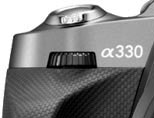 |
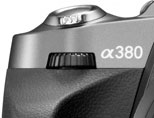 | |
The A330’s build quality is roughly similar to the other upper-entry-level DSLRs mentioned above, but while all four employ plastic shells, the Sony and Canon look the most plasticky thanks to their shiny finish across many surfaces. Nikon and Olympus employ a more textured finish which to our eyes make them look and feel slightly more professional, although again this is a personal preference. To be fair though, there’s certainly no creaks or poor joins to complain about here, with the A330 feeling well-assembled and reasonably solid.
Eagle-eyed Sony spotters will also notice that while the A330 may share the same body as the A380, it actually sports a subtly different textured finish on the grip areas: the random organic pattern on the A380 replaced with tiny squares in a regimented grid here.
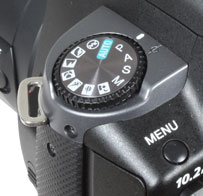 | 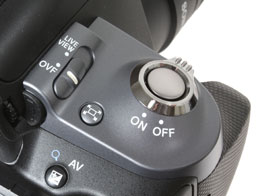 | |
Along with a redesigned body, Sony’s also rearranged many of the controls, again based on feedback from its target customers.
Some find themselves in more intuitive positions with better labelling, while rarely-used controls like the previous SteadyShot switch, have been sensibly relocated to the menu system. Most of the changes make sense and result in a layout that’s cleaner and more approachable for the DSLR beginners Sony is aiming for.
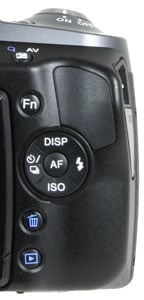 |
The main mode dial remains on the upper left surface, although now recessed with only one quarter of its edge exposed for adjustment. The upper right surface has been simplified with the previous ISO and drive mode buttons relocated to the rear, leaving the shutter release (with a new rotary power control) and the viewfinder / Live View switch now joined by the Teleconverter (digital zoom) button.
Turning to the rear, there’s now no longer any buttons running along the left side of the screen, and as mentioned above, the earlier separate power switch on the back has now been relocated to around the shutter release; only the Menu button finds itself in the upper left side.
The rest of the controls are to the right side of the screen, grouped around the usual cross-keys which like many rivals feature dual-functions with labelling to explain: push up to change the Display mode, push right to adjust the flash settings, push down to set the ISO and left to change the drive mode.
Above these are just two buttons: one labelled Fn and the other to adjust exposure compensation. We’ll fully describe the Fn button later on this page.
Completing the controls are delete and play buttons on the rear and an AF / MF switch by the lens mount, but sadly there’s still no optical depth-of-field preview button.
Overall, the redesign is a bitter-sweet experience for us, as while the new control layout is more intuitive and easier to use, we weren’t personally fond of the grip and physical ergonomics. As always, design and handling are a subjective opinion, so we’d recommend trying it for yourself.
Sony Alpha DSLR-A330 flash
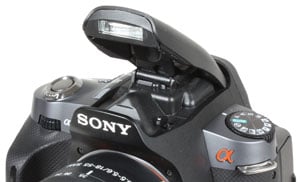 |
The Alpha A330 is equipped with a popup flash which is now hinged closer to the viewfinder, allowing it to rise much higher than its predecessor which was only hanged halfway.
The A380’s flash now rises to around 55mm above the top of the lens mount which is roughly the same as Canon’s EOS 1000D / Rebel XS. Sadly though the flash itself is relatively weak with a below average Guide Number of 10 compared to 13 on the Canon EOS 1000D / XS.
Pushing the cross-key right allows you to choose between fill-in (always-on), slow sync, rear-curtain sync and wireless flash options. With the flash popped-up, the A330’s main menu system also lets you adjust flash compensation in a range of +/-2EV. Note without a physical switch to raise the flash, you’ll need to enter the menus to force it to popup in anything other than the Auto modes – this is a bit slow for quick opportunities needing a fill-in.
On top of the A330’s head you’ll find a hotshoe for an optional flashgun and as you’d expect for its price point, there’s no PC sync port for external lighting. The A330’s flash synch speed is 1/160 whether you’re using SteadyShot or not. Sony also launched a new slim HVL-F20AM flashgun with the A330 and its siblings.
Sony Alpha DSLR-A330 viewfinder
The Alpha A330 is equipped with the same optical viewfinder as its predecessor, employing a penta-mirror arrangement to deliver 95% coverage with a meagre 0.74x magnification. While the coverage is similar to most rival DSLRs, the magnification is smaller than many: Canon’s EOS 1000D / XS and Nikon’s D3000 for instance have a magnification of 0.81x and 0.8x respectively which deliver a slightly bigger view when looking through their viewfinders, making composition and manual focusing a little easier and more comfortable. We also found it tricky to view the entire frame and exposure information on the A330 without our eyes pressed up against the viewfinder, so users of spectacles beware.
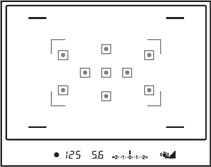 |
The reason the A330’s viewfinder looks relatively small is because Sony’s squeezed an additional sensor in there in order to deliver its innovative Live View system (fully described below). If you want Sony’s quick and fuss-free Live View system, then it’s a compromise you’ll just have to live with.
Running below the frame in the A330’s viewfinder is the usual basic exposure information: aperture, shutter speed and an exposure compensation scale, complemented by a five bar scale on the right side indicating how hard the SteadyShot system, is working (if enabled); remember as a sensor-shift system you won’t see the stabilising effect though the viewfinder, so this scale is the only indication of what’s happening behind the scenes. Sadly there’s no indication of the ISO permanently shown in the viewfinder – a shame since most rival models now offer this useful information at all times.
Like its predecessor, the focusing screen shows the same nine focusing points, but instead of single lines marking their positions, the A330 now uses more conventional squares – and like Canon’s cheaper DSLRs, a red dot illuminates in the middle of each to indicate when they’re active.
Finally, sensors below the viewfinder automatically switch the screen off when your eye approaches, and like earlier Alphas can also be configured to fire-up the AF system so the camera’s ready for action. Traditionalists may prefer to deactivate this feature though.
Sony Alpha DSLR-A330 Screen and Live View
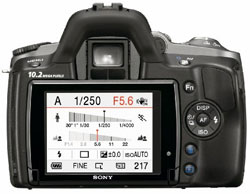 |
The Sony Alpha DSLR-A330 is equipped with a 2.7in / 230k pixel screen, the same specification as its predecessor. In use it’s fairly vibrant with a wide viewing angle, while a small sensor to its lower right corner measures ambient conditions and adjusts as necessary. If preferred, you can manually set the screen brightness, to avoid any exposure surprises from the default automatic adjustments.
Like its predecessor, the A330’s screen is mounted on a platform which allows vertical adjustments. The mounting itself has been redesigned though, allowing slightly greater downward travel than the A300 to an angle of 55 degrees, or as before you can tilt it to face directly upwards.
While this system doesn’t offer the same degree of flexibility as the fully-articulated monitors on the Nikon D5000 and Olympus E-620 which can twist round to face the subject or even back on themselves for protection, it still allows you to shoot more comfortably at low angles or high over the heads of crowds in Live View.
 | |
Articulated screens simply provide greater flexibility when composing in Live View, but those who like to pore over detail in playback may wish to trade-up to a model with a 3in VGA (920k) screen, such as Canon’s EOS 500D / T1i or Sony’s own Alpha A550. This is very much a personal one to weigh up, although anyone who frequently composes in Live View will prefer an articulated screen. The higher-end Alpha A550 offers the best of both worlds by mounting its 3in VGA screen on a platform which can tilt to face directly up or down.
Live View on the Sony A330 works like its predecessor, and as such is unlike most other systems on the market today. Typical Live View systems use the main sensor to deliver a live video feed to the display. This has the advantage of showing exactly what you’re going to record when you take the picture, but has the downside of requiring the internal mirror to lift and shutter to open.
This makes a sound, introduces a delay, and crucially, bypasses the traditional phase-change autofocus system. Most DSLRs which use their main sensor for Live View therefore offer two solutions to autofocus: first is to simply flip the mirror back down for a moment to take a reading from the phase-change system, before flipping-up to resume the live view, although this obviously makes additional noise and interrupts the display. Alternatively a contrast-based AF system (like a compact camera) can be used without interrupting the image, although to date these have been relatively slow on DSLRs.
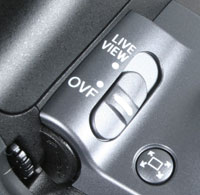 |
Uniquely the Alpha A330 (and the A380) do not use their main sensors for Live View. Instead they have a secondary sensor located just above the optical viewfinder in the penta-mirror chamber. A small mirror within this chamber can be used to direct the light either through the optical viewfinder, or to this sensor to provide a live feed to the screen. A secondary sensor is the part inspired by Olympus, although its earlier E-330 split the light path to feed it, resulting in a dimmer viewfinder.
The clever part about the Sony implementation is the Live View switch (on the upper right surface of the body) doesn’t just tilt this internal mirror, but also closes a shutter in the optical viewfinder during Live View to prevent stray light from entering. It’s mechanical and as such even works when the power’s off.
It’s also very quick in operation. With traditional Live View systems, we’ve become used to the delay and sound of the mirror and shutter opening. But with the A330 (and A380), Live View is quietly activated about a second after pushing that switch. And better still, because the traditional phase-change AF system isn’t being bypassed, the camera will autofocus as quickly as it did when you’re composing with the optical viewfinder – and unlike most other Live View systems you’ll still be able to use continuous autofocus to track moving subjects.
During Live View, the A330 displays approximately what you’d see if you were looking through the viewfinder, including the nine AF squares and 16:9 guides. At first you might assume these are superimposed graphics cleverly designed to match the viewfinder’s appearance, but of course the A330’s Live View sensor is simply filming the existing focusing screen.
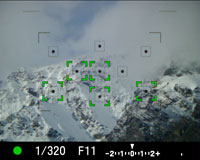 |
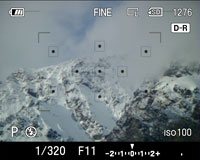 |
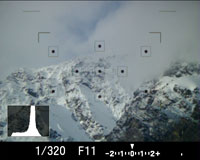 |
Rather than illuminate red dots when active though, the AF squares are surrounded by green markings – see screengrabs. The shutter speed, aperture and EV scale are shown along the bottom of the image, alongside a scale which (like the viewfinder) reveals how hard the Super SteadyShot system is working.
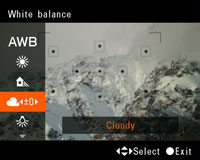 |
Pressing the DISP button overlays further shooting information including the mode, quality setting, shots remaining and sensitivity, along with the battery life, although sadly the percentage of charge remaining from the earlier A300 is now absent. Press the DISP again and this information is replaced by a live brightness histogram in the lower left corner. It all works very well indeed, although there’s no option to remove the AF markings for a clean view because of course they’re permanently in the way of the Live View sensor. It is useful to preview the White Balance during Live View though as seen in the screengrab to the right. You can manually tweak it to different settings or colour temperatures until you get the desired effect.
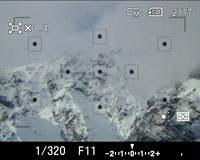 | 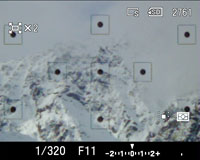 |
Less impressive is the Smart Teleconverter button which magnifies the image first by 1.4 times, then by 2 times. This isn’t to check the focusing though. It’s acting like a digital zoom to deliver images at the A330’s Medium and Small resolutions of 5.6 and 2.5 Megapixels respectively. You’ll also see the focusing screen markings magnify to occupy more of the view too.
| ||||||||||
If that were the only downside to the system we wouldn’t mind, but there’s other issues with Sony’s Live View implementation here. By exclusively using a secondary sensor to deliver the live feed, what you see on the screen is not absolutely what you’re going to get. Traditional Live View systems which use their main sensor to deliver the feed can show 100% coverage, while the A330’s Live View only shows 90% on-screen – that’s even less than the 95% of the optical viewfinder, so you may be surprised to capture more than you bargained for. It’s also lacking the highly magnified 1:1 views to confirm precision manual focusing and avoid errors with the phase-change system. And as discussed earlier, that clever optical system in the penta-mirror chamber also has a negative impact on the optical viewfinder magnification.
By effectively ‘filming’ what you’d see through the optical viewfinder, you won’t just see the A330’s focusing screen at all times, but also any dust or scratches which may accumulate on it. With the AF markings permanently shown, there’s also no easy way to superimpose additional graphics for alignment (so Sony hasn’t). And since only the main sensor is stabilised, you won’t be able to preview its effect in Live View, although to be fair, Olympus has now also disabled this function on its E-620.
So if you’re a technical photographer who demands 100% coverage, an alignment grid and 1:1 focus confirmation, then you’ll find the A330 (and A380) limiting. But for its target audience of DSLR beginners, the lack of fuss when switching between Live View and the optical viewfinder on the A330, not to mention its uncompromised AF performance is much preferable overall. Just think carefully about which Live View system will work best for your style of shooting.
It’s also worth noting Sony’s mid-range Alpha A500 and A550 models offer not one, but two different Live View systems: one using the secondary sensor (as seen here) for quick response, and the other using the main sensor for verifying manual focus at high magnification. Interestingly Sony doesn’t bother with any auto-focusing on the main sensor Live View option, but until contrast-based AF systems get quicker, these higher-end Alpha DSLRs are arguably offering the best of both worlds.
Sony Alpha DSLR-A330 shooting information and menus
Like most DSLRs these days, the Alpha A330 uses its main colour monitor to display all shooting information, and like its predecessor these details rotate by 90 degrees clockwise or anti-clockwise when you’re holding the camera in a portrait orientation; it’s a nice feature which means the text is always upright.
 |  |
Sony has however revamped the presentation for these latest Alphas in an attempt to make things easier for DSLR beginners. By default, the A330 starts with a new graphic view, which shows exposure information in a bar running along the top, and extended shooting information in two bars at the bottom.
So far, so normal, but the space in-between is occupied by two long wedges representing the shutter speed and aperture scales, with icons at each end indicating what impact they’ll have on your photos. The shutter speed scale has an icon of a still person on the left side representing slower exposures, while on the right side is an icon of a person running representing quick exposures.
In a similar style, the left side of the aperture scale with the smaller f-numbers shows an icon of a sharp person with a blurred mountain behind them, while on the right side with the bigger f-numbers is an icon where both the person and the background are sharp. Both graphically illustrate which end of the scale you’ll need to use to achieve these effects without having to explain depth-of-field or shutter speeds. More experienced users can press the DISP button to lose these graphics and fill the space with additional shooting information.
 |
Like its predecessors though, Sony’s resisted the option of rival models where settings can be highlighted and adjusted directly from the main screen. Instead, you’ll be using the cross-keys to fire-up dedicated menus for the ISO, drive mode and flash, and relying on the Fn button above them for other popular settings.
Like the A330 before it, pressing the Fn button divides the screen into six sections although now it’s much more colourful. As before you can adjust the AF mode, AF area, Metering Mode, White Balance and D-Range Optimizer, although since the Flash options have their own position on the right cross-key, the A330’s sixth function allows you to directly adjust the Creative Style.
An important new feature for the A330 (and its siblings) is the on-screen help guide, which pops-up a page of helpful information if you pause for a moment when adjusting a certain setting.
 |
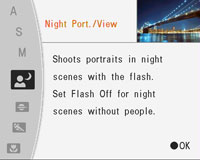 |
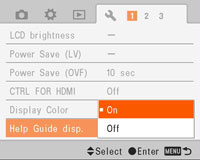 |
Switching between exposure modes and scene presets also presents an explanatory page, and on the whole these are very helpful for beginners. Once again, more experienced owners can switch them off if preferred.
 |
For all other settings you’ll need to dive into the main menu system, divided into seven tabbed pages which don’t scroll: two for Record, one for Setup, one for Playback and three for Configuration.
In playback you can switch between a clean view of the image, one overlaid with basic shooting information, and a thumbnail view with red, green, blue and brightness histograms; the view with five tiny thumbnails of previous images running along the top is no longer available. This simplifies matters, although zooming could be more intuitive – rather than offering zoom-in and zoom-out buttons, you’ll need to first press the exposure compensation button (labelled with a magnifying glass), then use the finger dial to adjust the zoom level (up to 12x on-screen or 5.1x over HDMI) and the cross-keys to scroll around. Additional playback options, such as displaying thumbnails or starting a slideshow, are accessible by pressing the Fn button, which once again presents six options.
All the menus in this review were grabbed over HDMI, although during playback, the signal formats itself to the 16:9 aspect ratio, hence the wider images below.
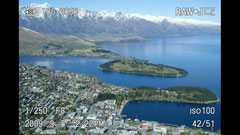 |
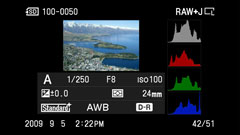 | 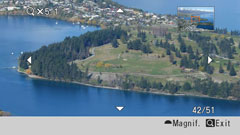 |
In a missed opportunity, given the built-in orientation sensors and rotating shooting information, portrait images don’t turn to fill the screen when the camera’s rotated by 90 degrees – shame.
Sony Alpha DSLR-A330 Battery and connectivity
|
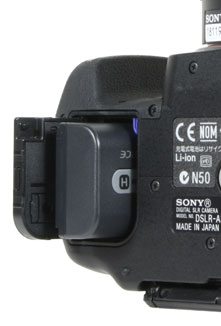 |
After powering its previous entire DSLR range (from A200 to A900) with the same NP-FM500H InfoLithium battery pack, Sony’s switched to the NP-FH50 pack on the A330 and its siblings to save a little space and weight. The new pack, also used in the Cyber-shot HX1 super-zoom and numerous Sony camcorders, may be around two thirds the weight of the previous FM500H, but loses almost half the capacity: it’s rated at 6.1 Watt Hours compared to 11.8 Watt Hours of the old model.
Since the internal electronics are very similar to its predecessor, this unsurprisingly has a negative impact on the number of shots you can take per charge: Sony quotes around 500 shots with the viewfinder on the A330, compared to 730 on the A300. Sadly despite using one of Sony’s InfoLithium batteries, the A330 also doesn’t provide the accurate percentage of charge remaining like earlier Alphas, instead relying on a segmented battery icon alone. This is a shame since having the percentage on-screen at all times was a key advantage Sony models had over the competition.
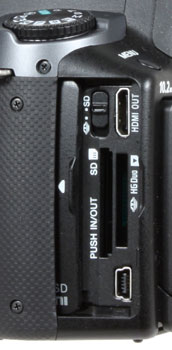 |
As a further slap beyond reduced battery life and basic feedback on remaining charge, the A330 also no longer has an optional battery grip. This was again a standard accessory across the earlier A200, A300 and A350 models, so enthusiasts wanting improved battery life or indeed something more to hold onto will have to look elsewhere, such as Canon’s EOS 500D / T1i or the Olympus E-620. Clearly it’s not a priority for Sony’s new target audience, although to be fair, Nikon doesn’t offer a battery grip for its D3000 or D5000 either.
Some of the biggest changes involve the ports and memory card slots. The earlier A300 employed a single Compact Flash memory card slot, located in the right hand grip like most DSLRs. With the A330 though, Sony’s switched this single Compact Flash slot for a pair of smaller slots, one unsurprisingly for the company’s own Memory Stick Pro Duo format, and the other for SD media. Uniquely both slots have also been relocated to the left side of the body, behind a large sliding door. Sadly you can’t record to both cards simultaneously for backup though, instead having to manually select one or the other with a tiny switch alongside the slots.
Joining the card slots behind the same sliding panel are two ports, and thankfully given Sony’s track record for proprietary technologies, both are standard: one is a USB output, and the other is a mini HDMI port, a new addition to the A330 and its siblings over its predecessor. It’s good to find an HDMI port, although in the excitement you may not have noticed the absence of a standard analogue TV output. As such, the A330 and its siblings become the first cameras we’ve tested which offer HDMI alone for connecting to a TV, so if you have an older set, you won’t be enjoying any big-screen slideshows. Finally, behind a small flap on the right side of the body is a DC input.






